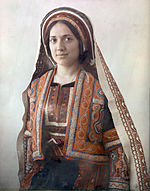


Intangible cultural heritage (Arabic: التراث الثقافي غير المادي) are elements of the cultural heritage of the State of Palestine which are abstract and must be learned, encompassing traditional knowledge including festivals, music, performances, celebrations, handicrafts, and oral traditions.
Starting in 2008, Palestinian hikaye was the first practice from Palestine to be inscribed by UNESCO; Palestinian embroidery was inscribed in 2021. Joint inscriptions with other Arab countries for Arabic calligraphy and date palm cultivation and use were inscribed in 2021 and 2022 respectively. Four further practices have been nominated for inscription: dabkeh and Nabulsi soap-making by the State of Palestine; metal engraving, and henna, with other Arab states.
Background
In 1993, as a response to the Oslo Agreement, significant investment was made in the protection of Palestinian cultural heritage. Subsequently to this, the inscription of Palestinian cultural heritage to the UNESCO lists gives international recognition to these practices. Despite this recognition, it has been argued by researchers that the intangible cultural heritage of Palestine has struggled to survive due to Israeli occupation. As a result of the ongoing Israeli occupation, Palestine's intangible cultural heritage has been influenced by the construction of internal borders prohibiting access to land, with the resultant effect of hindering traditional agricultural practices and the semi-nomadic lifeway of some communities. Systemic cultural appropriation of Palestine's heritage has been reported, for example the appropriation of traditional Palestinian embroidery in Israeli fashion.
In some cases, Palestinian heritage was destroyed by the occupying forces: for example in the South Hebron Hills, Palestinian cave houses were confiscated by Israeli forces and the residents evicted. This disconnected young people in the area from their heritage, and in order to reconnect to their identity they collected oral histories on the cave-based lifestyle. Support for intangible cultural heritage has also been proposed as a way to foster economic and environmental sustainability, for example in the village of Battir.
For many Palestinians continued connection with their cultural heritage is a form of resistance. Palestinian henna designs have had a resurgence in popularity, with a focus on olive designs, amongst others, as an act of resistance for women.
Intangible Cultural Heritage of Humanity
+ Transnational elementRepresentative List
| Name | Image | Year inscribed | No. | Description |
|---|---|---|---|---|
| Palestinian hikaye | 2008 | 00124 | A narrative form performed in Palestinian dialects, by women for women, usually during winter. | |
| Arabic calligraphy: knowledge, skills and practices + | 
|
2021 | 01718 | The artistic practice of writing Arabic letters and words to convey grace and beauty. |
| The art of embroidery in Palestine, practices, skills, knowledge and rituals | 
|
2021 | 01722 | Traditional embroidery used to decorate clothing, in particular women's. Motifs such as birds, trees and flowers are included, and designs are reflect regional identities. |
| Date palm, knowledge, skills, traditions and practices + | 
|
2022 | 01902 | There is a long history of cultivation and utilisation of the date palm in the region, which has led to the development of traditional crafts and social practises. |
| Dabkeh, traditional dance in Palestine | 
|
2023 | 01998 | A rural dance, performed by both men and women moving synchronously in a line, that has become a symbol of resistance. |
| Arts, skills and practices associated with engraving on metals (gold, silver and copper) + | 2023 | 01951 | ||
| Henna, rituals, aesthetic and social practices + | 
|
2024 | 02116 | A temporary tattooing practice with medicinal and aesthetic motivations. |
| Tradition of Nabulsi soap making in Palestine | 
|
2024 | 02112 | Made from olive oil, traditionally by women, this castille soap has been produced in Nablus since the fourteenth century. The industry was at its peak in the nineteenth century and went into decline in the mid-twentieth century. |
Other intangible cultural heritage
Traditional ecological knowledge (TEK) of wild plant usage in Artas has been considered as another form of intangible cultural heritage. Other forms of intangible cultural heritage that are not inscribed, or nominated for inscription, include: coffee preparation, maklouba, Palestinian architecture, Nablus cheese. Other intangible heritage beyond oral testimony from the South Hebron Hills, includes food practices of dried yoghurt and grape syrup, as well as traditional song.
See also
Notes
- Shared with Algeria, Bahrain, Egypt, Iraq, Jordan, Kuwait, Lebanon, Mauritania, Morocco, Oman, Saudi Arabia, Sudan, Tunisia, United Arab Emirates, and Yemen.
- Shared with Bahrain, Egypt, Iraq, Jordan, Kuwait, Mauritania, Morocco, Oman, Qatar, Saudi Arabia, Sudan, Tunisia, United Arab Emirates, and Yemen.
- Shared with Algeria, Egypt, Iraq, Mauritania, Morocco, Saudi Arabia, Sudan, Tunisia, and Yemen.
- Shared with Algeria, Saudi Arabia, Bahrain, Egypt, United Arab Emirates, Iraq, Jordan, Kuwait, Morocco, Mauritania, Oman, Qatar, Sudan, Tunisia, and Yemen.
References
- "UNESCO - Palestine". ich.unesco.org. Retrieved 2023-11-22.
- "UNESCO - Palestinian Hikaye". ich.unesco.org. Retrieved 2023-11-10.
- "UNESCO - The art of embroidery in Palestine, practices, skills, knowledge and rituals". ich.unesco.org. Retrieved 2023-11-10.
- "Calligraphy". Encyclopedia of Arabic Language and Linguistics. doi:10.1163/1570-6699_eall_eall_dum_0028. Retrieved 2023-11-10.
- "UNESCO - Date palm, knowledge, skills, traditions and practices". ich.unesco.org. Retrieved 2023-11-10.
- ^ "The role of dabke in preserving Palestinian culture in Argentina – Middle East Monitor". 2023-11-10. Archived from the original on 2023-11-10. Retrieved 2023-11-10.
- ^ IMEU. "Nablus' Olive Oil Soap: A Palestinian Tradition Lives On | IMEU". imeu.org. Retrieved 2023-11-10.
- "Files 2023 under process - intangible heritage - Culture Sector - UNESCO". ich.unesco.org. Retrieved 2023-11-22.
- ^ "Henna: rituals, aesthetic and social practices - intangible heritage - Culture Sector - UNESCO". ich.unesco.org. Retrieved 2023-11-22.
- Amiry, Suad, and Khaldun Bshara. "Political conflict and recovery of cultural heritage in Palestine." Cultural Heritage in Postwar Recovery. Rome: ICCROM (2007): 68-74.
- Butler, Beverley (June 2009). "'Othering' the archive—from exile to inclusion and heritage dignity: the case of Palestinian archival memory". Archival Science. 9 (1–2): 57–69. doi:10.1007/s10502-009-9095-0. ISSN 1389-0166. S2CID 143441885.
- Butler, Beverley (November 2009). "Palestinian Heritage 'to the moment': Archival Memory and the Representation of Heritage in Conflict". Conservation and Management of Archaeological Sites. 11 (3–4): 236–261. doi:10.1179/175355210X12747818485402. ISSN 1350-5033. S2CID 143774347.
- Soliman, Mahmoud; Sulin, Laura; Karlıdağ-Dennis, Ecem (2022-01-02). "Building Capabilities of Youth Through Participatory Oral History Project: The South Hebron Hills, a Palestinian Case Study". Journal of Human Development and Capabilities. 23 (1): 116–135. doi:10.1080/19452829.2021.2019690. ISSN 1945-2829.
- Mohamed Barak, Prof. Ahmad (2023). "Criminal Protection of Palestinian Traditional Knowledge in the Light of Intellectual Property Rights". SSRN Electronic Journal. doi:10.2139/ssrn.4492803. ISSN 1556-5068. S2CID 259699831.
- Rjoob, Ahmed A (November 2009). "The Impact of Israeli Occupation on the Conservation of Cultural Heritage Sites in the Occupied Palestinian Territories: The Case of 'Salvage Excavations'". Conservation and Management of Archaeological Sites. 11 (3–4): 214–235. doi:10.1179/175355210X12747818485367. ISSN 1350-5033. S2CID 109839958.
- Zayad, Luma (2017). "Systematic cultural appropriation and the Israeli-Palestinian conflict". DePaul Journal of Art, Technology & Intellectual Property Law. 28 (2): 81–125.
- ^ Soliman, Mahmoud; Sulin, Laura; Karlıdağ-Dennis, Ecem (2022-01-02). "Building Capabilities of Youth Through Participatory Oral History Project: The South Hebron Hills, a Palestinian Case Study". Journal of Human Development and Capabilities. 23 (1): 116–135. doi:10.1080/19452829.2021.2019690. ISSN 1945-2829.
- Kudumovic, Lana (2023-01-12). "Sustainability of the Palestinian historic village of Battir". Journal of Cultural Heritage Management and Sustainable Development. 13 (1): 28–42. doi:10.1108/JCHMSD-08-2020-0124. ISSN 2044-1266. S2CID 237755081.
- ^ "Palestine From Cairo series: On food, songs, tales, and architecture of resistance - Heritage special - Heritage - Ahram Online". 2023-11-22. Archived from the original on 2023-11-22. Retrieved 2023-11-22.
- Shurrab, Hatem. "Henna tattooing, a way to show belonging in Palestine". Henna tattooing, a way to show belonging in Palestine. Retrieved 2023-11-22.
- "UNESCO - Examples of Intangible Cultural Heritage in Egypt, Jordan, Lebanon and Syria*". ich.unesco.org (in Spanish). Retrieved 2023-11-10.
- Reporter, A. Staff. "UAE: Henna to be nominated to Unesco cultural heritage list". Khaleej Times. Retrieved 2023-11-22.
- "The tradition of Nablusi soap making in Palestine - patrimoine immatériel - Secteur de la culture - UNESCO". ich.unesco.org. Retrieved 2023-11-10.
- Hanna, Emily Mourad; Friborg, Katrine Gro; Qumsiyeh, Mazin B. (2022-04-03). "Temporal change in traditional knowledge and use of wild plants in Artas, Palestine". Palestine Exploration Quarterly. 154 (2): 81–94. doi:10.1080/00310328.2021.1975069. ISSN 0031-0328. S2CID 240519396.
- Harrowell, Elly; Sellick, Patricia (2023). "Contested heritage in Susya: Asymmetry and possibilities for peace". Cooperation and Conflict. doi:10.1177/00108367231205007.